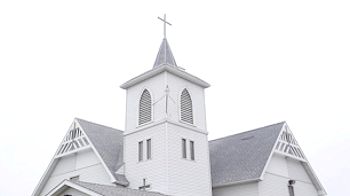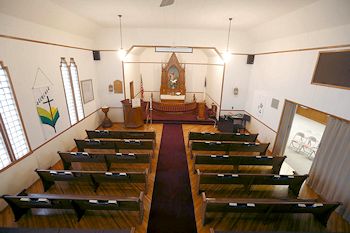From 1964 History of Red River Valley:
 "St. Olaf's Norsk-Luterzke Menighed" was organized Jan. 31, 1886 at Sven Ellingson's store in Reynolds. At this meeting Arne Haugen was elected president and Christian Vold, secretary. The first pastor was the Rev. Jens Iverson Lonne (1887-89) "St. Olaf's Norsk-Luterzke Menighed" was organized Jan. 31, 1886 at Sven Ellingson's store in Reynolds. At this meeting Arne Haugen was elected president and Christian Vold, secretary. The first pastor was the Rev. Jens Iverson Lonne (1887-89)
 The new congregation was placed in the Buxton parish which consisted of Buxton, Grue, North Praire, and St. Olaf's. During the pastorate of the Rev. Gustav M. Oftedal (1889-1902), a parsanage was purchased in Buxton by the parish. The new congregation was placed in the Buxton parish which consisted of Buxton, Grue, North Praire, and St. Olaf's. During the pastorate of the Rev. Gustav M. Oftedal (1889-1902), a parsanage was purchased in Buxton by the parish.
 At first the congregation met in various homes and schools. It was finally decided to alternate between the C.C. rural school and the Methodist Church in Reynolds. At first the congregation met in various homes and schools. It was finally decided to alternate between the C.C. rural school and the Methodist Church in Reynolds.
 At the same time, a building committee was elected. They reported on Jan. 7, 1890, that the location of the church would be on the land of Gunnerus Sauerud in Americus township [Note: aka Gunder Sauer, Section 21, Grand Forks County]. By a vote of 13 to 9, the congregation decided to build on that site. Because of the number opposed, it was decided also to build a chapel in Reynolds for the convenience of the members there. With this compromise, the matter was settled and fund-raising began. Construction began in 1891 and the church was dedicated the following year. At the same time, a building committee was elected. They reported on Jan. 7, 1890, that the location of the church would be on the land of Gunnerus Sauerud in Americus township [Note: aka Gunder Sauer, Section 21, Grand Forks County]. By a vote of 13 to 9, the congregation decided to build on that site. Because of the number opposed, it was decided also to build a chapel in Reynolds for the convenience of the members there. With this compromise, the matter was settled and fund-raising began. Construction began in 1891 and the church was dedicated the following year.
 With the church nearing completion in the country, however, the majority was no longer willing to build a chapel in Reynolds as originally planned. Sven Ellingson announced that he had 69 signatures of members in Reynolds who wished a church there, and that they wished to remain in St. Olaf's congregation, as the original plan had been. On Jan. 14, 1892, the majority again voted against building the chapel in Reynolds. The Reynolds members then resigned from the congregation "because it was too far to church (paa grund af for lang kirkevei)." The Ladies Aid also divided at the same time. With the church nearing completion in the country, however, the majority was no longer willing to build a chapel in Reynolds as originally planned. Sven Ellingson announced that he had 69 signatures of members in Reynolds who wished a church there, and that they wished to remain in St. Olaf's congregation, as the original plan had been. On Jan. 14, 1892, the majority again voted against building the chapel in Reynolds. The Reynolds members then resigned from the congregation "because it was too far to church (paa grund af for lang kirkevei)." The Ladies Aid also divided at the same time.
 The Reynolds group met at Sven Ellingson's store on Jan. 21, 1892, to plan their building and the name of Zion was chosen for the congregation. The church was constructed the next year. The congregation was served by pastors from Hillsboro. The Reynolds group met at Sven Ellingson's store on Jan. 21, 1892, to plan their building and the name of Zion was chosen for the congregation. The church was constructed the next year. The congregation was served by pastors from Hillsboro.
 St. Olaf's was often visited by the Red River Valley Inner Mission, which held prayer meetings and attempted to "awaken" the people. The most significant of these "awakenings" was during the 1898 meetings. The penitential, severe pietism of the Inner Mission meetings has greatly influenced the piety of the congregation. St. Olaf's was often visited by the Red River Valley Inner Mission, which held prayer meetings and attempted to "awaken" the people. The most significant of these "awakenings" was during the 1898 meetings. The penitential, severe pietism of the Inner Mission meetings has greatly influenced the piety of the congregation.
 In 1923, St. Olaf's and Zion, together with Stjordalen Congregation, decided to form a parish, and in 1926 the present parsanage in Reynolds was completed. In 1923, St. Olaf's and Zion, together with Stjordalen Congregation, decided to form a parish, and in 1926 the present parsanage in Reynolds was completed.
 Pastors who have served these congregations are: Jens Iverson Lonne, Gustav M. Oftedal, Ole T. Nelson, Thore Johnson Gronningen, Martin Oliver Ensberg, Peter Oas, Michael Luthre, Thomas Gabrielson, A. E. Norson, G. Victor Eilbertson, and at present Win Mott. Pastors who have served these congregations are: Jens Iverson Lonne, Gustav M. Oftedal, Ole T. Nelson, Thore Johnson Gronningen, Martin Oliver Ensberg, Peter Oas, Michael Luthre, Thomas Gabrielson, A. E. Norson, G. Victor Eilbertson, and at present Win Mott.
Article from the Fargo Inforum
June 7, 2015
By Marilyn Hagerty
 NEAR REYNOLDS, N.D. – St. Olaf Lutheran Church has stood for more than a century as a landmark 16 miles south of Grand Forks on Highway 81. NEAR REYNOLDS, N.D. – St. Olaf Lutheran Church has stood for more than a century as a landmark 16 miles south of Grand Forks on Highway 81.
 It has been the country church for rural people around Reynolds, N.D. Lutheran Norwegian immigrants founded the church in 1886. It has been the country church for rural people around Reynolds, N.D. Lutheran Norwegian immigrants founded the church in 1886.
 And Sunday, the last service in the big white church was held at 10 a.m. Now all of its services will be moved to Zion Lutheran Church of Reynolds, where a meal was served following services at the country church. And Sunday, the last service in the big white church was held at 10 a.m. Now all of its services will be moved to Zion Lutheran Church of Reynolds, where a meal was served following services at the country church.
 The two churches have merged. At the end of 2014, parishioners voted to close St. Olaf and use just the church in town. It’s part of the continuing story of fewer people going to church in rural areas and finances involved. The two churches have merged. At the end of 2014, parishioners voted to close St. Olaf and use just the church in town. It’s part of the continuing story of fewer people going to church in rural areas and finances involved.

 Earlier in 2014, the two churches had become a three-point parish with rural Highland and Immanuel Lutheran churches of Buxton, N.D. Earlier in 2014, the two churches had become a three-point parish with rural Highland and Immanuel Lutheran churches of Buxton, N.D.
 So the remnants of the congregation found their favorite pew in St. Olaf’s Church for the last time Sunday. They heard a closing sermon by Associate Bishop Charlie Axness, associate with Bishop Terry Brandt of the American Lutheran Church of America (ALCA). So the remnants of the congregation found their favorite pew in St. Olaf’s Church for the last time Sunday. They heard a closing sermon by Associate Bishop Charlie Axness, associate with Bishop Terry Brandt of the American Lutheran Church of America (ALCA).
 On the beautiful old wooden altar, the Norwegian words: Herre, Freils Mig. The meaning, “Lord save me,” have been a focal point for parishioners for 129 years. On the beautiful old wooden altar, the Norwegian words: Herre, Freils Mig. The meaning, “Lord save me,” have been a focal point for parishioners for 129 years.
 The church is large. It is white. It has a bell tower you can see for miles. There never was a cemetery, but there is one grave of an infant. The church is large. It is white. It has a bell tower you can see for miles. There never was a cemetery, but there is one grave of an infant.
 Greg Saure said last week the church holds 200 people, and there is a side room with extra seating, as well as a main floor dining room. Saure is a sixth generation of the family whose farmland surrounds St. Olaf’s Church. Greg Saure said last week the church holds 200 people, and there is a side room with extra seating, as well as a main floor dining room. Saure is a sixth generation of the family whose farmland surrounds St. Olaf’s Church.
 Like other lifetime members of St. Olaf’s, he has mixed emotions about leaving the building that has been loved, cherished and supported. At the same time, the parishioners are realistic. Like other lifetime members of St. Olaf’s, he has mixed emotions about leaving the building that has been loved, cherished and supported. At the same time, the parishioners are realistic.
 When they decided to sell the building, they knew they would rather see it torn down or moved. Anything would be better than watching it fall into a state of disrepair. When they decided to sell the building, they knew they would rather see it torn down or moved. Anything would be better than watching it fall into a state of disrepair.

 There was a time when people of St. Olaf had their favorite places to sit in church. In early years, there was a place to tie up their horses. The young people were confirmed. They came to St. Olaf to be married. The first marriage on June 29, 1890, was that of Gilbert Gilbertson Oas and Celia Josephine Claudine Gilbert. There was a time when people of St. Olaf had their favorite places to sit in church. In early years, there was a place to tie up their horses. The young people were confirmed. They came to St. Olaf to be married. The first marriage on June 29, 1890, was that of Gilbert Gilbertson Oas and Celia Josephine Claudine Gilbert.
 Minutes for meetings of St. Olaf Church from 1886 until 1937 were recorded in Norwegian. The first record of a Luther League for youth was around 1909. In those days, the youth group was known as “Ungdomsforening.” Minutes for meetings of St. Olaf Church from 1886 until 1937 were recorded in Norwegian. The first record of a Luther League for youth was around 1909. In those days, the youth group was known as “Ungdomsforening.”
 As time went on, St. Olaf’s Church joined area churches of Zion and Stordalen to build a parsonage in 1926 in Reynolds for its joint pastors. It was designed by Joseph Bell DeRemer, a Grand Forks architect. As time went on, St. Olaf’s Church joined area churches of Zion and Stordalen to build a parsonage in 1926 in Reynolds for its joint pastors. It was designed by Joseph Bell DeRemer, a Grand Forks architect.
 The style of St. Olaf Church resembles churches in the homeland of its founders from Norway. The style of St. Olaf Church resembles churches in the homeland of its founders from Norway.
 Sunday, parishioners brushed back the tears. They knew the time had come. Sunday, parishioners brushed back the tears. They knew the time had come.
 As the final service drew near, Saure said, “This building has served its purpose.” As the final service drew near, Saure said, “This building has served its purpose.”
|
